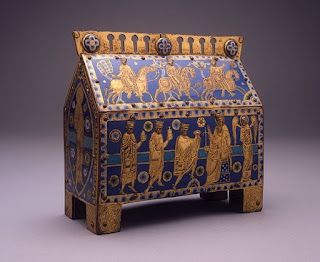为什么起步走和稍息都迈左脚
(Why
in queue first move the left foot)?
黎显慧
百度知道中有网友问:军训时,为什么起步走要先动左脚?稍息为什么要迈出左脚,而不是右脚呢?有网友回答说:习惯问题,可能西方有无聊的科学家会研究吧。
这问题当真无聊?
现代行军是先左后右,稍息出左脚也比较常见。短时间伸出左脚没问题,长时间,会感觉累。双脚替换则比较舒适。因此,稍息则不都是出左脚。比如美国的要求是双腿自在,但不可以移动位置。德国则是移动右脚约20 -30厘米 。加拿大是双脚分开若肩宽,俄罗斯联邦则是任何一条腿的膝关节松动。
稍息可以理解为一种站姿,从舒适的角度看,伸出左脚与伸出右脚没有区别,为何通常为伸出左脚?
至于起步走先出左腿,似乎有一定道理。有人解释:大多数人都是右撇子,脚也是一样,迈左脚后,身体重量就在右脚上了,会比较舒服。雅虎知道中也有类似问题,回答者说:当你用左脚向前一步,你有一个更好的战斗姿态。[1]
有人从中医的角度来解释,任脉贯穿于左腿,主血液流动,督脉贯穿于右腿,主精气流动,先动左腿是让血先行。[2]
还有人从文化角度来解释。认为先左后右,这是传统。也就是说,这规矩是古人流传下来的。
走路时先出左脚,站立时也伸出左脚,如果将这个现象解释为肢体语言的话,可以理解为尊左。尊左是世界远古文明的共同特征,先左后右是十分古老的传统。
在古埃及,人们以各种肢体语言来表示尊左,最常见的便是站立时伸左脚,队列中先出左脚。
原始小雕像日常生活,埃及[5]
世界各地早期文明中也有这一文化特征。
恩利尔,古代美索不达米亚的风暴之神,卢浮宫藏[8]
苏美尔和马里士兵的防御性装备[9]
巴力雕像,乌加利特,叙利亚国家博物馆,阿勒颇[11]
古代波斯人有翼的神[12]
巴比伦众神,雪花石墙板,大英博物馆[14]
萨尔贡二世宫殿的石膏墙浮雕,新亚述时期,
避免拉玛什图伤害的护身板,新亚述,卢浮宫博物馆[16]
浮雕,十二个冥界神在赫梯圣所,哈图沙附近雅兹勒卡亚,土耳其[18]
赫梯战士[19]
古代佩拉斯吉亚神话中的宙斯[20]
五位阿兹特克勇士[27]
法典门多萨所描绘的阿兹特克战士[28]
阿兹特克人献祭,墨西哥[29]
黄帝像,砖画[30]
仪仗出行画像砖,河南博物院[31]
起步走和稍息都迈左脚,源自母系社会的尊左礼俗。尊左具有母神崇拜的色彩,是宗教的源头、文化的根。先左后右,是世界远古文明的传统。人类进入父系社会后,尊左礼俗受到不同程度的破坏。尽管尊左的时代离我们远去,但文化深层的尊左总会以不同形式显露出来,队列训练中的以左为先便是一例。
[1] So
when you step forward with a left foot, you're in a better fighting posture.
[3] Statuette of a King,12th Dynasty, Reign of Amenemhet II or Senusret I,Cairo Antiquities Museum.From touregypt.net.CopyRights 1996-2018 Tour Egypt. All Rights Reserved.
[4] Archers,Asyut,
Tomb of Prince Mesehti,Eleventh Dynasty, 2134-1991 B.C.,Cairo Museum, Egypt..by
lilei(china).
[5] Original
figurines everyday life ,Egypt.© 2014 - Amigos del antiguo Egipto.
[6] Detail
of fresco depicting a funeral procession,Tomb of Ramose, Valley of the Nobles,
Thebes, Luxor. 18th Dynasty.From egypt.egypt-museum.
[7] Relief,servants
carrying rope and weapons,Mortuary Temple of Ramesses III, Medinet Habu. 20th
Dynasty, ca. 1186-1155 BC. From egypt.egypt-museum.
[8] Enlil,was
the ancient Mesopotamian god of wind, air, earth, and storms.Louvre Museum.Photo
By Li Xianhui.
[9] The
defensive armaments of the soldiers of Sumer and Mari,by Juan-Luis Montero
Fenollós - University of Coruña,From A blog related to wargaming in the
Near East in the Third Millennium.
[10] Bronze
figurine of a Baal, 14th x 12th century BCE, found at Ras Shamra (ancient
Ugarit) near the Phoenician coast. Louvre Museum.From wikipedia.
[11] Aleppo,Museum
- Baal Statue aus Ugarit (ca. 10 cm),copyright © Hans-Peter Grumpe.
[12] Ancient
persian Winged God. Louvre Museum, Photo By Li Xianhui.
[13] Phoenicians
bringing gifts for the Persian King, Persepolis relief, 5th century
B.C.E.Copyright (c) Journey to the Source.
[14] Alabaster
wall panel; relief; from left to right a Lahmu, Ugallu or great lion and the
house god,© The Trustees of the British Museum.
[15] Protective
Spirit Palace of Sargon II, Khorsabad (ancient Dur-Sharrukin), Iraq.
Neo-Assyrian period, 710-705 BCE. (The British Museum, London). By Osama Shukir
Muhammed Amin.
[16] Neo-Assyrian
protection plate against Lamashtu. Louvre Museum. From wikivisually.
[17] Hittite
God,Classic Hittite Empire,1600-1400 BC,Gold. From bible-history.com.Copyright
© 2001 The Louvre Musée.
[18] Relief
,Yazilikaya, a sanctuary at Hattusa,twelve gods of the underworld,By
Klaus-Peter Simon,From wikipedia.
[20] Zeusi
në mitologjinë e lashtë pellazge përfaqëson kreun e perëndive.By LILJANA DHE
LUFTULLA PEZA:ZEUASTIKA - NJË SIMBOL I LASHTË PELLAZG.Copyright © 2006 - 2012
Portali Pashtriku.org.
[21] Limestone
statue of a bearded man with votive offerings.ca.475–450 B.C. Cypriot.©
2000–2016 The Metropolitan Museum of Art.
[22] Limestone
priest.Archaic. end of the 6th century B.C.Cypriot.© 2000–2016 The Metropolitan Museum of Art.
[23] The
three Wise men bringing gifts to the baby Christ. 6th c. mosaic from Ravenna
(St. Apollinarius).From greecetravel.com.
[26] The
god India pays homage to the Buddha ,India, Region of Mathura c. 2nd century AD
,From Renzo Freschi : Myth and Rituals,© Renzo Freschi.
[27] Five
Aztec Valiant Warriors and Captains,By Mexicoarms,From Berdan cs op.cit 1997
p.134-135,©Hubert de Vries 2014-01-30.
[28] Aztec
warriors as depicted in the Codex Mendoza,By Unknown - Foundation for the
Advancement of Mesoamerican Studies, Inc.[1] Original document held at the
Bodleian Library, Oxford. Shelfmark MS.From wikipedia.
[29] The raising
of the poles and the sacrifice of children in the month of Atlcahualo. Primeros
Memoriales . By Julia Flood,From Mexicolore,God of the Month:Tlaloc.




























